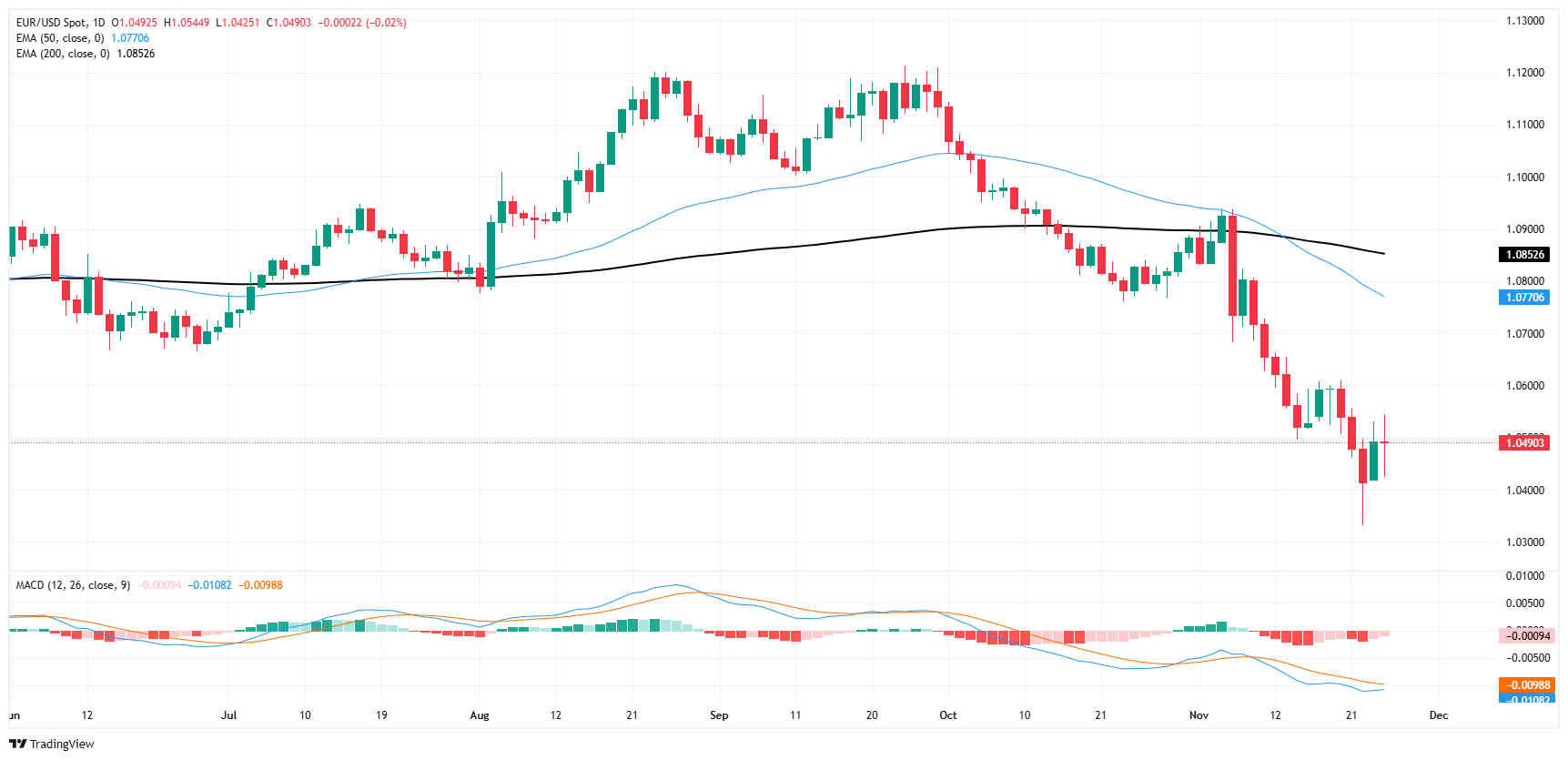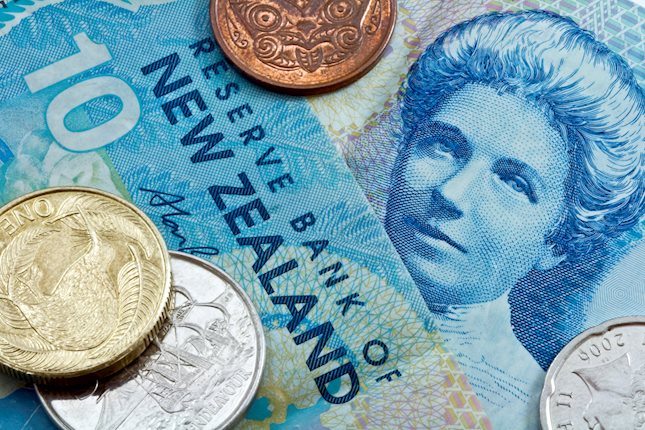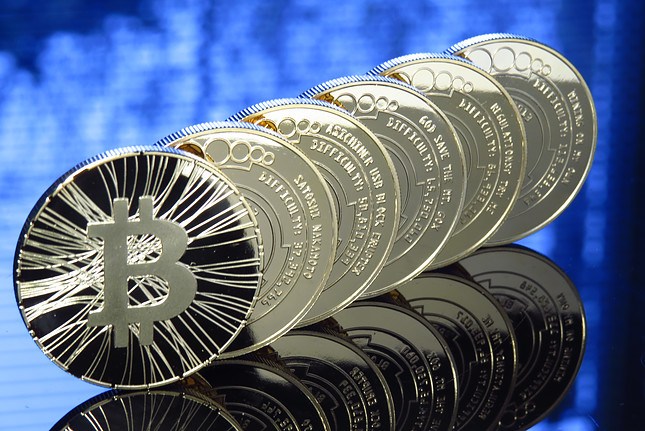- EUR/USD struggled to find momentum on Tuesday, stuck near 1.0500.
- The trading week has been shortened by a US holiday on Thursday, limited Friday hours.
- EU inflation figures are due on Friday, with a thin calendar until then.
EUR/USD cycled the 1.0500 handle on Tuesday, with Fiber price action drifting into the near-term middle ground as directional momentum drains out of the pair. The economic calendar is an overall thin affair this week, with the US Thanksgiving holiday on Thursday trimming late-week market momentum. US markets will also see limited trading hours on Friday, further crimping the week’s potential for big plays.
According to the Federal Reserve's (Fed) latest Meeting Minutes, members of the Federal Open Market Committee (FOMC) continue to remain cautious about the pace of rate cuts looking forward. Overall, the Fed's key group of policymakers seemed to agree that downside risks in the employment landscape and inflation outlook have decreased. Still, the pace of rate cuts is unlikely to accelerate further unless weak points open up in the jobs market and price growth starts to slump. According to the CME's FedWatch Tool, rate traders have slightly solidified bets of a 25 bps rate trim when the Fed makes its final rate call of 2024 on December 18, with rate markets pricing in 60% odds of a quarter-point rate cut and the remaining 40% expecting a rate hold.
This week sees a firm drought of EU-based datapoints through most of the week, with a fresh round of European Harmonized Index of Consumer Prices (HICP) inflation slated for Friday. Preliminary pan-EU HICP inflation for November is set to swing higher on an annualized basis, a looming threat that European Central Bank (ECB) policymakers have been scrambling to get out in front of. According to ECB officials, a near-term uptick in broad EU inflation metrics shouldn’t be a cause for concern for investors.
Wednesday will bring another update to US Personal Consumption Expenditure Price Index (PCEPI) inflation, a key reading of price increases underpinning the US economy. Wednesday also brings a quarterly update of US Gross Domestic Product (GDP) growth. Annualized core PCEPI inflation is set to accelerate again in October and forecast to increase to 2.8% from the previous 2.7%. QoQ US GDP growth in the third quarter is expected to hold steady at 2.8%.
EUR/USD price forecast
EUR/USD caught a bid on Greenback softness to retest the 1.0500 handle earlier this week. However, Fiber buyers remain unable to break through the key technical metric neatly, and the pair is set to continue struggling with familiar technical barriers in the near term. EUR/USD price action has found some breathing room after hitting a 24-month low late last week, but the climb up is looking very far for Fiber bulls to reclaim anything approaching bullish territory.
EUR/USD daily chart
Euro FAQs
The Euro is the currency for the 19 European Union countries that belong to the Eurozone. It is the second most heavily traded currency in the world behind the US Dollar. In 2022, it accounted for 31% of all foreign exchange transactions, with an average daily turnover of over $2.2 trillion a day. EUR/USD is the most heavily traded currency pair in the world, accounting for an estimated 30% off all transactions, followed by EUR/JPY (4%), EUR/GBP (3%) and EUR/AUD (2%).
The European Central Bank (ECB) in Frankfurt, Germany, is the reserve bank for the Eurozone. The ECB sets interest rates and manages monetary policy. The ECB’s primary mandate is to maintain price stability, which means either controlling inflation or stimulating growth. Its primary tool is the raising or lowering of interest rates. Relatively high interest rates – or the expectation of higher rates – will usually benefit the Euro and vice versa. The ECB Governing Council makes monetary policy decisions at meetings held eight times a year. Decisions are made by heads of the Eurozone national banks and six permanent members, including the President of the ECB, Christine Lagarde.
Eurozone inflation data, measured by the Harmonized Index of Consumer Prices (HICP), is an important econometric for the Euro. If inflation rises more than expected, especially if above the ECB’s 2% target, it obliges the ECB to raise interest rates to bring it back under control. Relatively high interest rates compared to its counterparts will usually benefit the Euro, as it makes the region more attractive as a place for global investors to park their money.
Data releases gauge the health of the economy and can impact on the Euro. Indicators such as GDP, Manufacturing and Services PMIs, employment, and consumer sentiment surveys can all influence the direction of the single currency. A strong economy is good for the Euro. Not only does it attract more foreign investment but it may encourage the ECB to put up interest rates, which will directly strengthen the Euro. Otherwise, if economic data is weak, the Euro is likely to fall. Economic data for the four largest economies in the euro area (Germany, France, Italy and Spain) are especially significant, as they account for 75% of the Eurozone’s economy.
Another significant data release for the Euro is the Trade Balance. This indicator measures the difference between what a country earns from its exports and what it spends on imports over a given period. If a country produces highly sought after exports then its currency will gain in value purely from the extra demand created from foreign buyers seeking to purchase these goods. Therefore, a positive net Trade Balance strengthens a currency and vice versa for a negative balance.
Information on these pages contains forward-looking statements that involve risks and uncertainties. Markets and instruments profiled on this page are for informational purposes only and should not in any way come across as a recommendation to buy or sell in these assets. You should do your own thorough research before making any investment decisions. FXStreet does not in any way guarantee that this information is free from mistakes, errors, or material misstatements. It also does not guarantee that this information is of a timely nature. Investing in Open Markets involves a great deal of risk, including the loss of all or a portion of your investment, as well as emotional distress. All risks, losses and costs associated with investing, including total loss of principal, are your responsibility. The views and opinions expressed in this article are those of the authors and do not necessarily reflect the official policy or position of FXStreet nor its advertisers. The author will not be held responsible for information that is found at the end of links posted on this page.
If not otherwise explicitly mentioned in the body of the article, at the time of writing, the author has no position in any stock mentioned in this article and no business relationship with any company mentioned. The author has not received compensation for writing this article, other than from FXStreet.
FXStreet and the author do not provide personalized recommendations. The author makes no representations as to the accuracy, completeness, or suitability of this information. FXStreet and the author will not be liable for any errors, omissions or any losses, injuries or damages arising from this information and its display or use. Errors and omissions excepted.
The author and FXStreet are not registered investment advisors and nothing in this article is intended to be investment advice.
Recommended content
Editors’ Picks

NZD/USD trims gains to near 0.5850 as RBNZ Orr speaks
NZD/USD has trimmed gains to reverse near 0.5850 early Wednesday. The New Zealand Dollar found fresh buyers after the RBNZ announced 50 bps interest rate cut to 4.25%, as widely expecteed but RBNZ Governor Orr's prudent remarks check the pair's upside.

USD/JPY stays pressured below 153.00, US data eyed
USD/JPY slides to over a two-week low below 153.00 early Wednesday as Trump's tariff threats continue to drive haven flows towards the JPY and exert pressure on spot prices. That said, doubts over the BoJ's ability to tighten its monetary policy further should cap gains for the JPY. US data eyed.

Gold price consolidates amid mixed cues; holds comfortably above $2,600
Gold price struggles to capitalize on the overnight bounce from the $2,600 neighborhood or over a one-week low and trades with a mild negative bias on Wednesday. The prevalent risk-on environment, expectations for a less dovish Fed, elevated US bond yields and the underlying bullish sentiment surrounding the USD act as a headwind for the commodity.

Bitcoin remains short of $100K as long-term holders capitalize on recent price rise
Bitcoin (BTC) trades below $95K on Tuesday following increased selling pressure among long-term holders (LTH) after a series of new all-time highs (ATH).

Eurozone PMI sounds the alarm about growth once more
The composite PMI dropped from 50 to 48.1, once more stressing growth concerns for the eurozone. Hard data has actually come in better than expected recently – so ahead of the December meeting, the ECB has to figure out whether this is the PMI crying wolf or whether it should take this signal seriously. We think it’s the latter.

Best Forex Brokers with Low Spreads
VERIFIED Low spreads are crucial for reducing trading costs. Explore top Forex brokers offering competitive spreads and high leverage. Compare options for EUR/USD, GBP/USD, USD/JPY, and Gold.